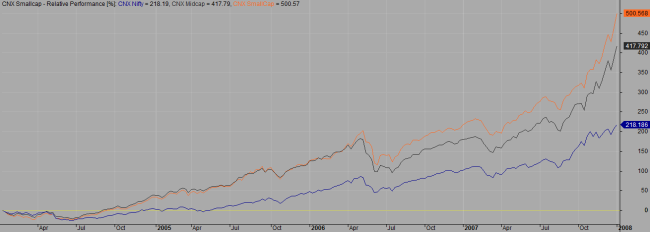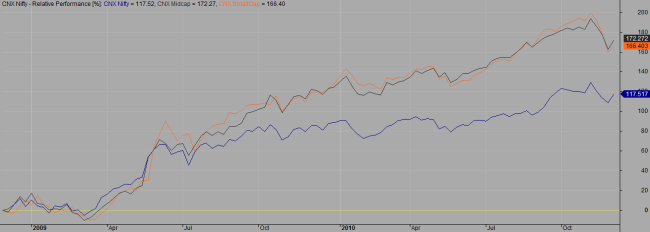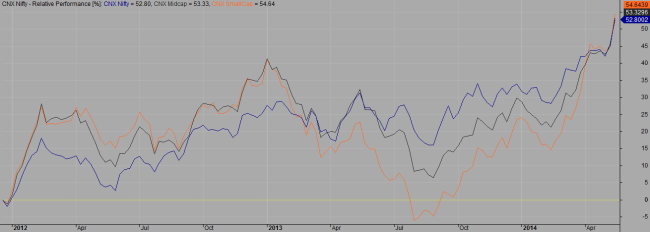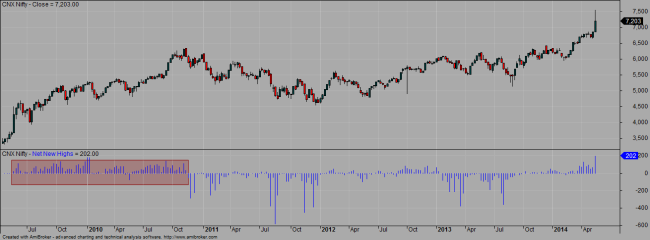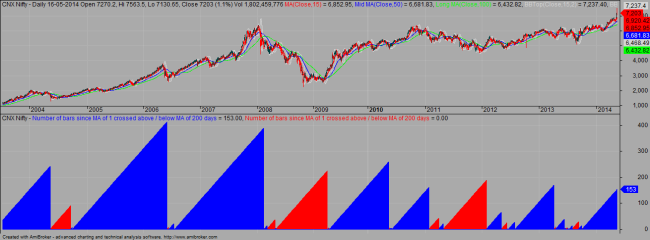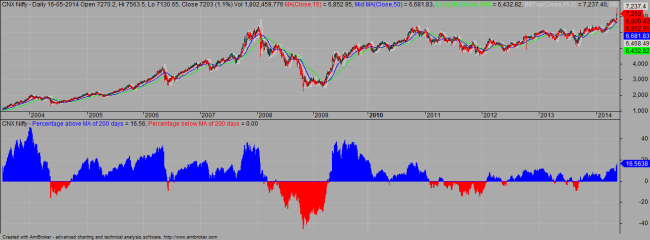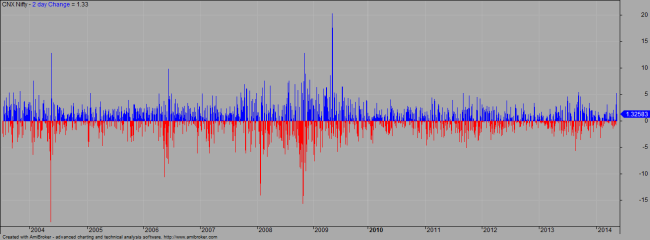While Nifty did close positive, the very fact that we gained just about 100 points for a victory of the kind unseen since 1977 (non congress) does in a way reduce the enthusiasm about whether markets are really ready to take off or are we seeing a topping out formation.
On one hand, this move of today has a precedence in the way markets behaved on the day of results of 2004. Nifty closed with a small positive despite the fact that NDA which was seen as the front runner to the next government came up short and instead it was the Congress supported by the Left parties who were staking their claim to power. What happened in the next two days is history.
With the comprehensive victory for Modi, I believe most broking houses will start upgrading their targets for Sensex / Nifty on the back of optimism generated by the slogan of Modi “minimum government maximum governance”. In fact, UBS has already confirmed its target of 8000 for Nifty.
They key question is, Shall we see a run away rally? On the basis of evidence (some of which I shall present here), I guess not. But what I am sure off is the fact that this could be a turning point in the Indian Economy. The last such turning point in my opinion was the 1991 elections where P V Narasimha Rao took over the Premiership after India’s first experiment with coalition politics had brought the economy virtually to its knees. Over the next 5 months, Sensex rallied by around 29% (in hind-sight though, this was the led by Harshad Mehta). Since the markets never re-tested levels seen in the first few months of PVN, I believe that genuine progress in between (with economy being opened up) added up to the rise in markets and all of it were not due to the scam.
Where we do differ from 1991 is in terms of how cheap or expensive the markets were at that point of time. Right now, Nifty trailing PE (Standalone) is around 19.5 while Sensex PE when PVN took charge was 15.5. But since Indian economy was closed and we were growing at a much lower pace, this additional risk is not as big as it appears to be.
Small and Mid Cap index stocks are generally those having high beta and hence these stocks tend to ourperform the large cap indices. A look at the past data seems to suggest that markets tops have been accompanied by strong out-performance of Small Cap Index vs Nifty whereas at the current juncture, all Indices seem to be moving in tandem and there appears to be still some way to go before a major top is made.
Chart 1 – RS comparison of CNX Small Cap, CNX Mid Cap and CNX Nifty
Period: Jan 04 – Dec 07
Chart 2 – RS Comparison of the same indices for period Oct 2008 to November 2010
Chart 3 – the current stage. Time period starting from Jan 2012
In the second pane of the chart below, I have plotted the Net New Highs in NSE. This is a way to gauge the breadth of the market since if markets are moving higher with very few stocks making new yearly highs, its just a matter of time before such move collapses.
I have marked in a box the period from the election results of 2009 to the top we saw in late 2010. One can see the consistent nature of the new highs. On a similar nature, I believe that we are just seeing the start of a run up as its just recently that the Net New Highs has broken into positive territory.
In recent times, whenever India has seen a strong government at the center, markets in the next one year have given pretty good positive returns. The only times when this did not happen was in 1999 when NDA formed the government. The hitch if one were to say is the fact that we have been strongly out-performing the world markets (majority of them) in a big way even before the ink on the fingers (elections) were set.
During the last days, we saw the release of CPI for the month of April which came in at 8.59% and March IIP data which once again was in negative territory 0.5%. With Diesel prices being raised by 1.09 right after the elections got over, Inflation numbers over the coming months will not be easy to vanquish. This is seen by the strong yields in Government Bonds which despite the euphoria closed yesterday at 8.83%.
Below is a Nifty chart with the lower panel showing the number of days since the 200 MA was breached. As can be seen, we are nowhere close to new highs but at the same time, we are coming in close to the highs reached after the market topped out in 2010.
Another way to look at the above data would be to measure the % difference between the current price and 200 MA and the same is plotted in the chart below
Once again we can see that this rally is nowhere comparable to the ones we had seen earlier before markets topped out for the medium to long term despite Nifty trading at its all time highs.
Even in a bull market, markets do not go up in one straight action but is pretty choppy on the extreme short term. As can be seen in the chart below, Number of occasions when Nifty suffered a loss of 5% of more during the bull phase of 2003 – 2008 is much higher than the ones we have seen since 2010. In fact, we have seen more instances of 5% up over 2 days than 5% down over 2 days, but as the market evolves, look forward to more of them.
The Narendra Modi government that comes to power is coming with the highest expectation one has ever seen (since 1977 I assume) and that in itself can turn out to be a negative for markets since its not easy for even a guy who has showcased the development of Gujarat to turn around the story overnight.
At the same time, I believe that the next couple of years provide one the best opportunity to set up the foundation for what Rakesh Jhunjhunwala will call “The mother of all bull rallies”. As I sign off, here is me, hoping for the best 🙂

